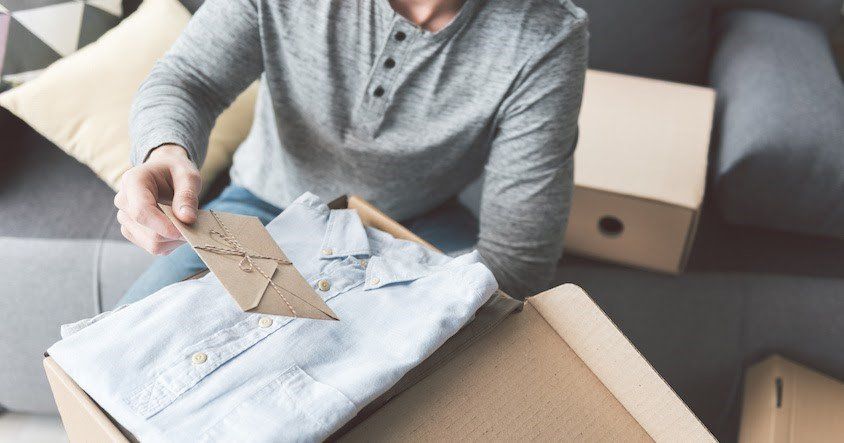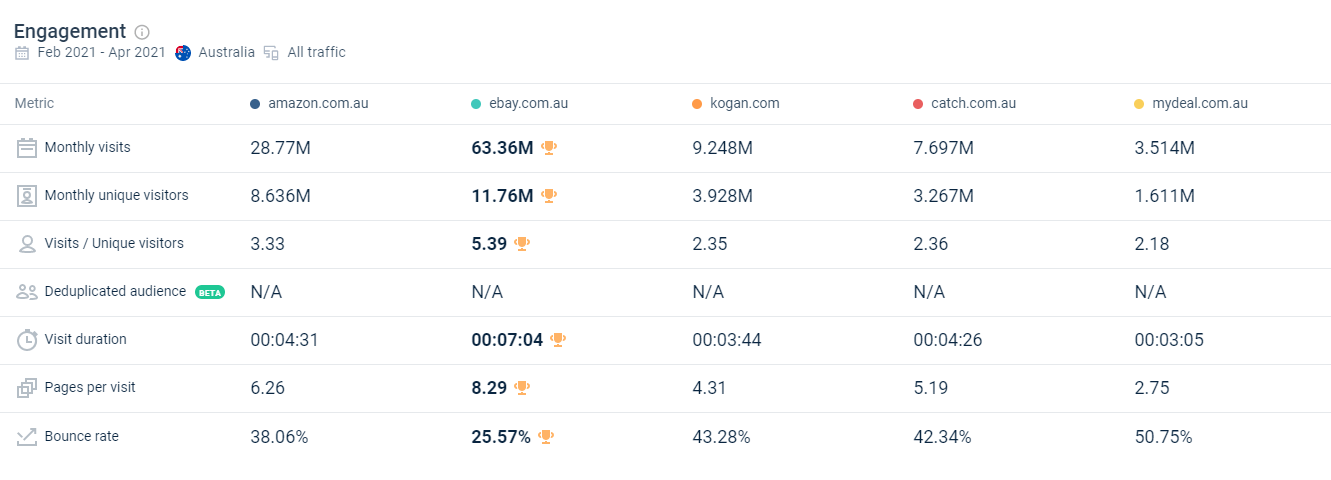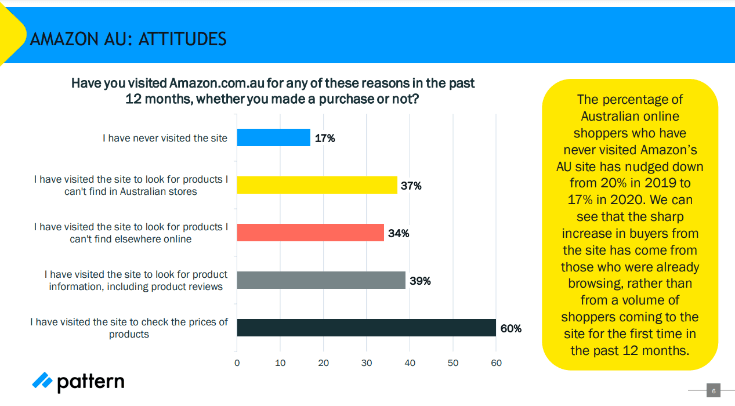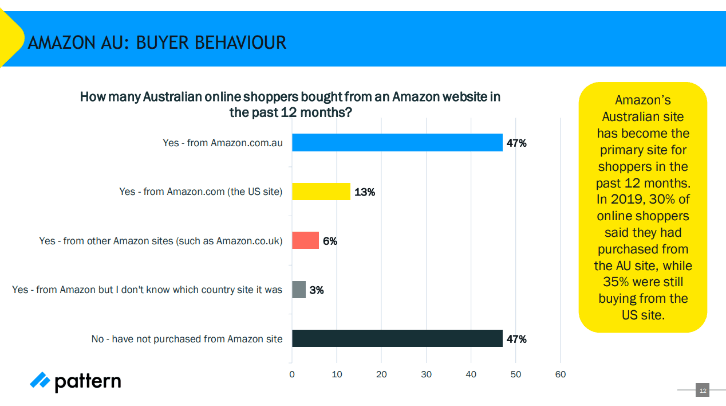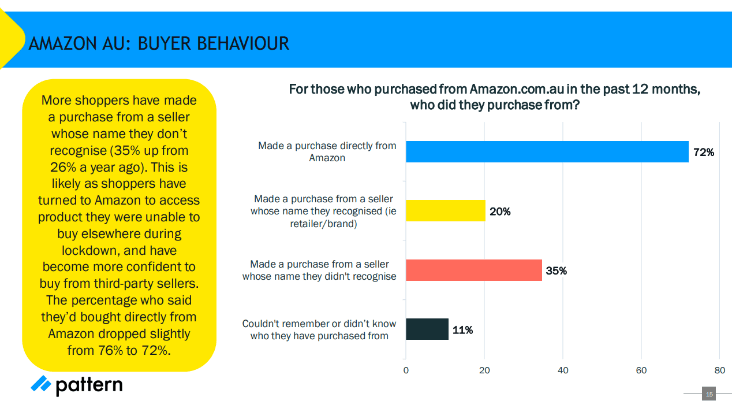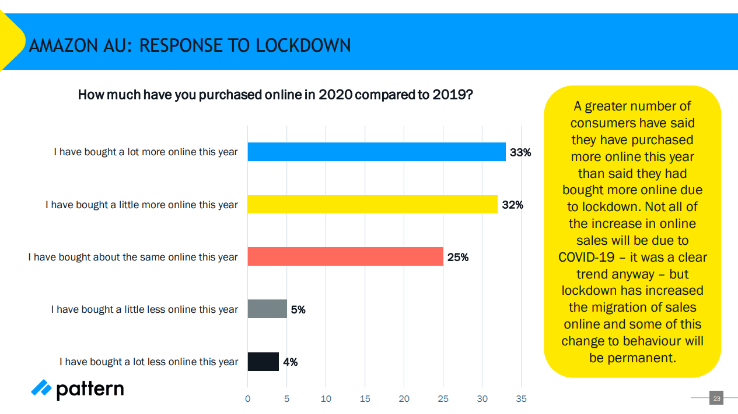What is Happening on Amazon Australia
We started with Costco and there was Netflix. Now, the world’s largest eCommerce platform has hit the land of down under, our beloved Australia. It has now been more than 4 years since Amazon launched its retail offering in Australia. Over this period, we have seen countless 'dramatic' headlines about its launch and effect on the Australian retail industry.
When Amazon "set up shop" in Australia, there was a lot of excitement, a lot of hopes, and a lot of fear. Then what? There's a little hissing going on. Some (premature) applause - but mostly there was a lot of silence. But hey, don’t assume defeat just because things are quiet down under. Amazon Australia had a sluggish year when it first launched in 2017. However, establishing operations in a new country takes time, luckily Amazon is here for the long haul.
More product ranges, brands, Prime and more are now available on Amazon Australia. As a result of all these changes, Amazon can now absorb a greater portion of Australia's e-commerce retailing. More importantly, let us not forget how Amazon has the challenge of dethroning its biggest rival in Australia, eBay. With a revenue of $292.3 million, the eCommerce platform increased its revenue in Australia by 1,500 per cent from 2017 to 2019.
So now we can all agree that despite its lacklustre start, Amazon is on track to dominate Australia's retail market.
Let’s take a look at Amazon Australia milestones down below and explore how they are tracking now and into the future.
Amazon Australia Has Faced Many Obstacles Along the Way
Amazon Australia had an incredibly soft launch on November 23 in 2017. The launch had Australians wondering if they would see Amazon up and running before Christmas.
But finally! Amazon officially launched in Australia in December that year. Amazon's website instantly transitioned from a Kindle store presence to a fully-fledged Amazon.com.au, with millions of items ready for eager Christmas shoppers across more than 20 categories.
Amazon have come far since their first day in the land of down under. For all intents and purposes, the Australian version Amazon is identical to the multinational retailer's other regional offerings. It has the same look and feel as other Amazon websites, but with an emphasis on the Australian market – and prices in Australian dollars to match. It has all the standard Amazon products, as well as the marketplace offering, which allows third-party vendors to list and sell their products.
However, when Amazon was initially launched in Australia there were a few key features that were different:
There was no Amazon Prime - despite the availability of Prime video and music streaming platforms, there were no Prime delivery methods.
Only a few selling features were available - unlike Amazon.com or other regional versions, the selling features were sparse – aside from the bare bones stuff.
Limited product listings – In contrast to other Amazon sites, Amazon.com.au had a small number of listings. The platform wasn’t selling many items either, with third-party listings accounting for 90% of existing listings.
The primary explanation for these initial distinctions is that Australia was basically a brand-new Amazon marketplace and an unusual one.
Between 2017 to 2019, although online purchases were common, when it comes to eCommerce, Australia was a bit of an anomaly. Despite the fact that it has the world's 12th largest economy, at the time online transactions accounted for just 10% of total retail sales. E-commerce was not as common in Australia as it is in the rest of the world – at least not yet.
According to a study by Power Retail, while the awareness of Amazon is high, only 6% of Australia’s online shoppers were actively engaged with the platform. More than half of Australian shoppers did not consider Amazon to be the cheapest option. This is why they were more likely to browse for products and purchase from their favourite brick and mortar stores or existing online retailers than they were to be searching and purchasing from Amazon.com.au.
Another reason why Amazon – and eCommerce, in general, had a rough start in Australia is the geography. The island is vast – it is the size of the continental United States – but there are vast, remote areas, with little inland infrastructure. When it comes to the population Australia is the world's most dispersed, making delivery and scheduling difficult. Expectations of two or three weeks are common, so eCommerce is not as quick and easy as it is in other countries.
Then there was Amazon’s new rule to prevent Australians from making purchases off the US store – or any other Amazon markets - which didn't help as the delivery timelines were LONG. This decision by Amazon was in fact what slowed their pace, consumer confidence and adoption.
Amazon Australia Is Still Finding Its Way
Despite the challenges, Amazon Australia is now poised to become the company's fastest-growing marketplace. Amazon has worked hard to earn the trust of its Australian customers and to provide the care they require and now the Aussies are starting to feel “The Amazon (Australia) Effect”.
In just a year, Amazon Australia grew from nothing to a marketplace with 10,000 Australian sellers, 100,000,000 products, and nearly 90% of Australians receiving free two-day delivery on local products as soon as they sign up for Prime.
Source: Marketplace Pulse
By the end of 2018, consumer awareness of Amazon (vs pre-launch in Australia) had risen from 48% to 73%. Between 2017 and 2018, the number of customers who are likely to buy from Amazon tripled. In addition, Amazon's online traffic increased by 42 per cent after the launch... and it's still growing until now.
According to the company, its first "Prime Day" subscriber sales event on July 16 and 17 resulted in the two highest days of sales and traffic since its launch.The Amazon Australia timeline reveals key steps the marketplace took to infiltrate Australian culture, with the launch Amazon Prime, Amazon Advertising and Amazon FBA being a significant step. Their subscription delivery and TV streaming service are half the price of their American counterpart. The service advertised free two-day shipping, unlimited eBook access, and other benefits.
The existence of Amazon Prime and FBA in Australia creates a powerful contrast when it comes to customers comparing the experience of buying products from the Amazon vs other Australian marketplaces. Those who purchased from other online retailers were likely to receive their items within 1-2 weeks, whilst those who purchased from Amazon sellers receive theirs within 2 days. Some shoppers are starting to notice the impact of Amazon and FBA, which is why FBA usage, Prime membership and total platform growth go hand in hand in Australia.
Following the availability of Prime membership and FBA, the global retail giant has also expanded their Australian operations by opening new fulfilment centres, logistic sites, and parcel pick-up locations / HUB all across the country. Plus, they are nearly completing their first Amazon Robotics fulfilment centre in Sydney. Spanning 200,000 square metres, the new fulfilment centre will create more than 1,500 local jobs working alongside advanced robotics.
That is quite an achievement!
Source: Marketplace Pulse

Amazon.com.au Vs Other online players in Australia
In Australia, nearly all online marketplaces are booming, giving brands and sellers more ways to attract customers. When it comes to competition, however, research by Web Retailer shows that up to this year, Australia is one of a handful of countries where Amazon does not dominate eCommerce. eBay remains Amazon Australia’s biggest competitor.
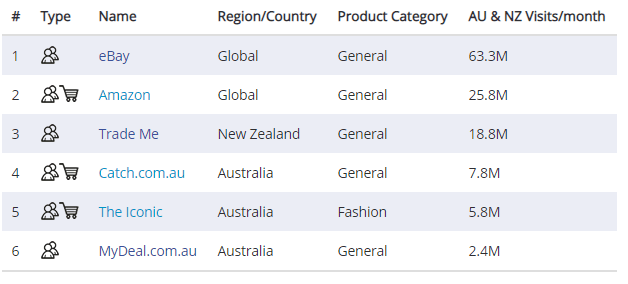
Source: Web Retailer
This table shows the most popular sites used by shoppers in the Australasia region (Australia and New Zealand) in 2020. By far the most popular online marketplace in Australia is eBay. Amazon is comfortably positioned in second place.
This is the one place where eBay's traffic exceeds Amazon's – eBay gets more than twice as much traffic from Australasian customers as Amazon. A more recent report by Similar Web also shows that from February to April 2021, eBay still beats Amazon and remains the number one marketplace in Australia with the highest monthly visits.
Source: SimilarWeb
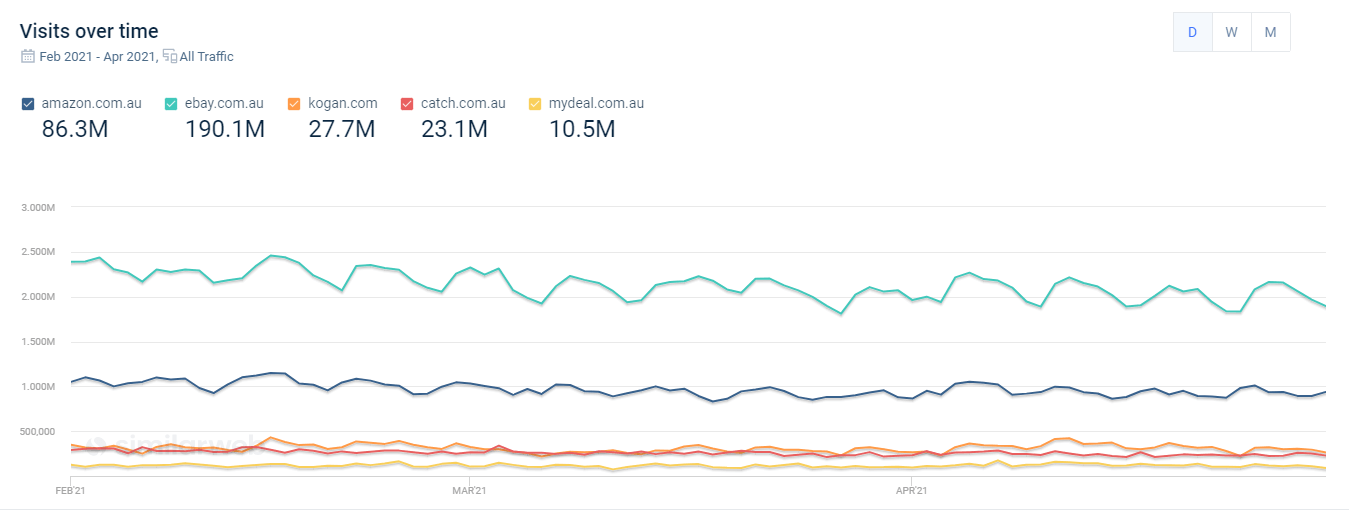
Source: SimilarWeb
eBay's image as an online auction house, a place to find one-of-a-kind pieces or used goods, is still prevalent. In order to maintain its position as the top Australian shopping site eBay is trying to shed it’s ‘Auction’ image but still remains as a common perception. Amazon, on the other hand, is only known for stocking new goods from major brands at reasonable prices and providing a value proposition of "great selection, delivered quickly" (along with price and convenience) has raised the bar for Australian marketplaces.
The looming launch of Amazon in 2017 sent shivers across the Australian industry. Major Australian retailers Myer, Harvey Norman, and JB Hi-Fi are down 47%, 25%, and 22%, respectively, from their peak share prices in 2016. That is not all Amazon's doing, but it shows the fear of how the eCommerce giant can change a market sentiment.
By contract since Amazon’s Australian launch in 2017, Amazon.com.au has experienced rapid domestically unrivalled growth. Its monthly visits have risen to 25.8 million (41 per cent of eBay's) in just three years and are expected to continue to rise. Australians, like shoppers in other countries, prefer a quicker and more convenient shopping experience, and Amazon excels in this.
This shows that Amazon’s commitment to Australia should not be underestimated. With the launch of FBA, Prime subscription and other strategies adopted by Amazon, the 'Amazonification' of customer perceptions will undoubtedly continue to spread across the country.
Amazon Australia during the COVID-19 Pandemic
Even as cloud growth slowed due to the coronavirus crisis, eCommerce was the highlight of Amazon's second-quarter financials, propelling the tech giant to new heights.
In Australia, sales of goods on the Amazon e-commerce website brought in $511 million, more than double the previous year's $218 million. The sales of Amazon's third-party retailers, also known as its marketplace arm, increased to $126 million.
In a new report from Pattern, Australian online shoppers are turning to Amazon more than ever, driven by the lockdown. The percentage of online customers who report they have shopped on Amazon.com.au has risen more than 50% between 2019 and 2020 and mostly admitted that pandemic-induced lockdowns are the main reason why these purchases were made from the marketplace.
Web traffic data from Similar Web also shows that the monthly visits to Amazon.com.au have risen by 49.5% between February and July this year.
According to the Pattern study, 27% of Amazon customers said the marketplace has aided them during times of lockdown. While it is true that 31% of customers said that they were shopping less because of the pandemic, 53% admitted they were spending more online than ever before. Overall, 65% said they would buy more online in 2020, with the study indicating that even without the lockdown, online purchases would have increased this year. The pandemic, on the other hand, has exacerbated an emerging trend.
During a press release in 2020, Matt Furlong discussed Amazon Australia Consumer Trends Report. He said that 2020 has radically altered all facets of Australians' daily lives, including how we shop, socialize and turn our homes into workplaces, gyms, cinemas and more. The findings of Amazon Australia's 2020 Consumer Trends study shed light on some of the latest hobbies that Australians are taking up, such as baking and arts and crafts, as well as their renewed emphasis on health and wellness all of which have related products that can be bought from Amazon.com.au.
What’s the future of Amazon Australia?
Will this increase sales trend be temporary for Amazon?
The answer is no.
When Amazon Australia was first introduced to the Australian market two years ago, it had a rocky start. Despite the hype, the user experience did not translate as easily as it should have once the platform was launched.
However, Amazon Australia has risen to the occasion and introduced several strategies that have seen it become the company's fastest-growing marketplace. Amazon is unquestionably on the way to becoming a global success, just as it has been in other countries.
Sure, the upward trend of Aussie shoppers purchasing from Amazon has been accelerated by lockdowns. But based on surveys after surveys, this change is not temporary.
Even with stores open again, buyers’ behaviour has been altered for the longer term. The eCommerce marketplace has helped customers during the period of lockdown. Amazon Australia has benefited from the closure of physical stores, impressing customers with its expanding product range, availability, and distribution capability through the lockdown.
Within ten years, Amazon's massive investment in the Australian retail market could see the American juggernaut claim nearly a third of all online sales or more.
Sellers or brands that have never considered Amazon Australia as a route to market should recognise it can offer incremental revenue and brands that have considered it in the past year should reconsider. Whereas for existing Australian marketplaces, they will need to bring their A-game, from digital marketing and brand placement to digital innovation and investing in a comprehensive omnichannel experience, there is a lot to think about.
To compete with Amazon, they will need to be continually developing a compelling value proposition.
More importantly, ‘If you can’t beat them, join them’. Sellers or brands should use Amazon Australia as a marketing and distribution platform for their products. If you are ready to start selling on Amazon or would simply like to learn more about Amazon here in Australia, get in touch with our Amazon experts and schedule an appointment. We at MerchantSpring will be happy to help you with the right tools and services to be a successful seller on Amazon Australia.
